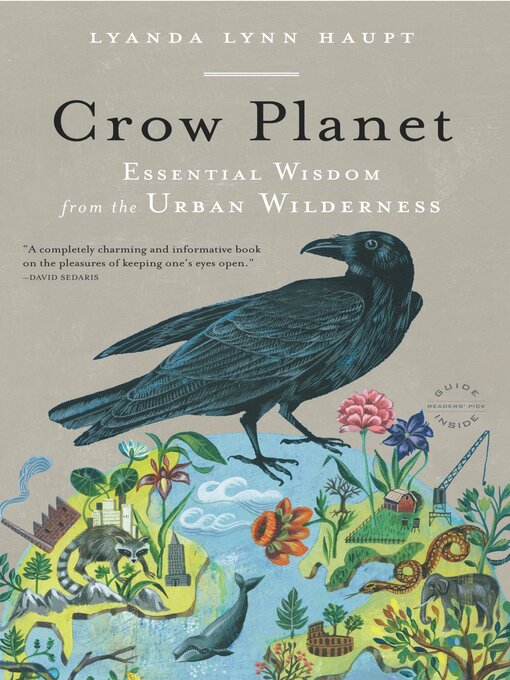Crow Planet richly weaves Haupt's own "crow stories" as well as scientific and scholarly research and the history and mythology of crows, culminating in a book that is sure to make readers see the world around them in a very different way.
-
Creators
-
Publisher
-
Release date
July 27, 2009 -
Formats
-
OverDrive Read
- ISBN: 9780316053396
-
EPUB ebook
- ISBN: 9780316053396
- File size: 4075 KB
-
-
Accessibility
No publisher statement provided -
Languages
- English
-
Reviews
-
Publisher's Weekly
April 6, 2009
Haupt, former raptor rehabilitator and seabird researcher, embarks on an urban ornithological expedition to defend the honor of the crow, the ubiquitous bird whose corvid
family precedes Homo sapiens
by several million years and whose symbolic and actual role as a scavenger and “liaison” between life and death evokes reactions ranging from revulsion to awe. Attracted to the sight of the birds nesting in her backyard, the author follows them as they forage in the moss along neighborhood streets and cavort in a nearby wildlife preserve. Her forays into Seattle’s “tenacious wild” demonstrate evidence of the crow community’s social complexity, their extensive vocabulary and fierce loyalty to their mates and species, Haupt enlivens her observations with tidbits from crow mythology and history, discovering that their bad press dates to the 14th-century outbreak of the bubonic plague when the birds scavenged the dead bodies lying in the streets, “beginning, horribly, with the eyeballs.” Despite some awkward prose, Haupt succeeds in humanizing the object of her naturalist obsession and affection. -
Kirkus
May 15, 2009
A self-described posthippie ecofeminist offers a quiet, genial book of"hopeful possibility" amid the current ecological crisis.
Wildlife researcher and rehabilitator Haupt (Pilgrim on the Great Bird Continent: The Importance of Everything and Other Lessons from Darwin's Lost Notebooks, 2006, etc.) writes gracefully about the interactions between crows and humans in the urban landscape and what those interactions portend for the future of the zoöpolis (where human and animal geographies overlap). For most people, notes the author, crows are the most commonly encountered native wild animal. Her fascination with the unusually intelligent birds began after a long depressive funk. One day she looked out her study window, saw an injured fledgling perched on an electrical wire and took the bird in. While nursing it back to health, she began to feel better. Haupt then spent two years studying the shiny black songbirds in her backyard and neighborhood. Found in growing numbers—there are more than 30 million in the United States—in densely populated towns and suburbs, the omnivorous American Crow thrives on the detritus of modern urban life, consuming everything from road kill to bread crumbs, bagels and McDonald's fries. The author discovered that watching the creatures mate, nest, forage and help one another encouraged a necessary awareness of the continuity between human lives and that of other species. Like her beloved Thoreau—who wrote,"There is no wildness distant from ourselves"—Haupt celebrates the interconnectedness of all life and urges readers to pay close attention to their home places. The chapter on the habits of amateur urban naturalists is a neat how-to guide for anyone interested in learning how the wild, nonhuman animals around us live. Even though we are unable to view our entire planet, she writes, we can take positive action by cultivating a sense of wonder at the wildlife at our door:"We practice wonder by resisting the temptation to hurry past things worth seeing."
A fresh take on conscious living in the everyday world.(COPYRIGHT (2009) KIRKUS REVIEWS/NIELSEN BUSINESS MEDIA, INC. ALL RIGHTS RESERVED.)
-
Library Journal
July 20, 2009
Haupt (Rare Encounters with Ordinary Birds) delivers a delightful meditation on our role in the natural world. By focusing on the proliferation of the American crow, she provides a rich context for exploring the relationship between humans and nature. Crows are one of the most easily identifiable, intelligent, and prolific birds whose abundance stems from their unique ability to cohabitate with humans. Haupt contends that with a little effort, humans can tap into the natural environment even in the most urban of areas. Verdict Highly recommended for birders but especially fans of Bernd Heinrich (The Mind of a Raven) and Marie Winn (Central Park in the Dark).-Diana Hartle, Univ. of Georgia Lib., AthensCopyright 2009 Library Journal, LLC Used with permission.
-
Loading
Why is availability limited?
×Availability can change throughout the month based on the library's budget. You can still place a hold on the title, and your hold will be automatically filled as soon as the title is available again.
The Kindle Book format for this title is not supported on:
×Read-along ebook
×The OverDrive Read format of this ebook has professional narration that plays while you read in your browser. Learn more here.



